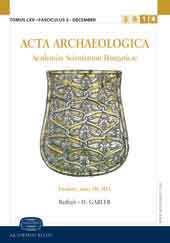Ceramics from Carniola at Bajcsavár, a 16th century border castle in southwestern Hungary
Ceramics from Carniola at Bajcsavár, a 16th century border castle in southwestern Hungary
Author(s): Gyöngyi KovácsSubject(s): Archaeology, Cultural history, Visual Arts, Middle Ages
Published by: Akadémiai Kiadó
Keywords: Ceramics; arcaheology; Carniola; Bajcsavár; 16th century; southwestern Hungary;
Summary/Abstract: During processing of ceramics finds recovered at a Turkish-era castle in southwest Hungary, I noticed some that bore stylistic marks suggestive of the late Renaissance in Italy. Despite being very few in number, they constituted a group among the many hundreds of kilograms of pottery unearthed that was clearly distinct, on the basis not just of the bisque used, but also of the colours and decoration featured. On first acquaintance I thought that they might be examples of 16th-century Italian ceramic art, although closer examination did not support this conjecture. (Their possible Italian origin was eventually ruled out following work in Vienna libraries that was supported by Professor Csanád Bálint, our director at the Archaeological Institute of the Hungarian Academy of Sciences.) Based on scattered data, my research now took a different direction. Feelings I was beginning to have were reinforced during a study trip to Slovenia. Here I should especially like to thank Professor Mitja Guštin (head of the Institute for Mediterranean Heritage, University of Primorska) for giving me the opportunity to make this visit to Slovenia in 2007 after considering my questions. I am also grateful to other Slovene archaeologists who assisted me during this study tour, among them Jože Štukl (Loka Museum of Škofja Loka) who photographed and described the Škofja Loka fi nds presented here.
Journal: Acta Archaeologica Academiae Scientiarum Hungaricae
- Issue Year: 60/2009
- Issue No: 1
- Page Range: 253-274
- Page Count: 22
- Language: English
- Content File-PDF

